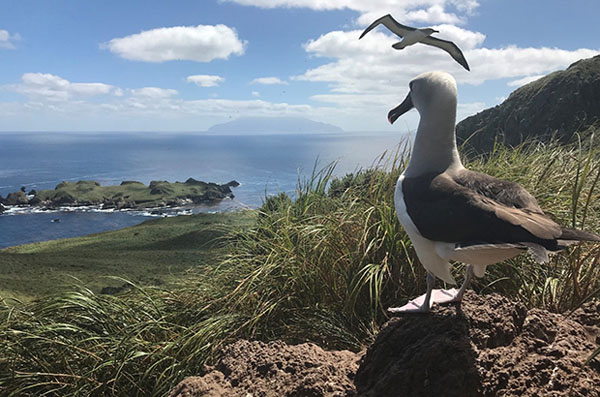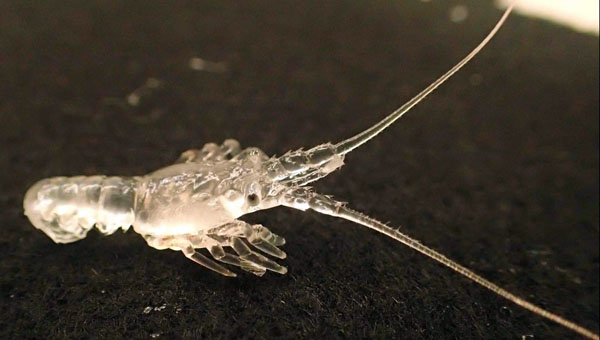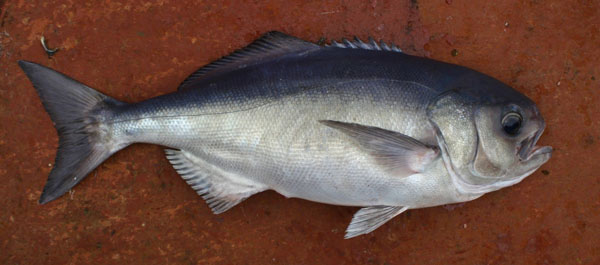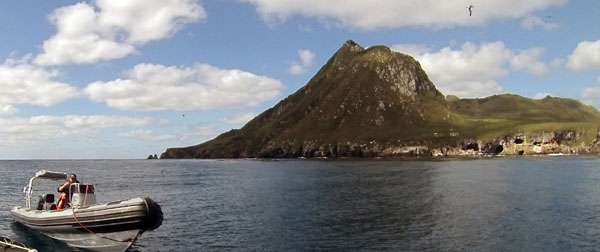Tristan Blue Belt Summary
Report by Oliver Yates, Hannah Thomas, James Bell, Martin Collins, Andy Deary,
Simon Morley and Sean Burns with photos from Oliver Yates (unless stated otherwise).
In September 2016 the UK Government made a commitment to protect 4 million square kilometres of ocean, forming a "Blue Belt" around the UK Overseas Territories (UKOTs) by 2020. The Foreign and Commonwealth Office (FCO) has tasked the Centre for Environment, Fisheries and Aquaculture Science (Cefas) and the Marine Management Organisation (MMO) with helping the UKOT governments deliver on this commitment. This initiative, called the Blue Belt Programme, will see Cefas and MMO work in partnership with the UKOT governments and stakeholders to conduct scientific research and develop bespoke management and enforcement strategies for each of the seven UKOTs in the Programme.
Tristan da Cunha, the world’s most remote inhabited island, and the neighbouring islands of Nightingale, Inaccessible and Gough in the Tristan da Cunha archipelago lie in the centre of the South Atlantic Ocean at 37° latitude, the very edge of the "roaring forties", where volatile weather systems from the South Atlantic create highly dynamic ocean conditions that can be tranquil one moment and a force to behold the next. Driven by the convergence of oceanic currents and upwellings around volcanic seamounts, Tristan’s marine environment is highly productive, supporting abundant marine flora and fauna sufficient to support one of the largest and most diverse seabird breeding colonies in the world.
The Tristan community of just over 250 is very much in tune with the ocean, working at sea when the weather permits and affording it due respect when conditions are rough. Islanders are particularly reliant upon nearshore fisheries for both food and income, and have established careful management practices to ensure their efforts are sustainable. By all accounts, Tristanians and their wildlife are well deserving of a marine protection strategy that will benefit them for generations to come.

Tristan da Cunha as seen from Nightingale Island (by an Atlantic yellow-nosed albatross!)
The Tristan community will determine the design of their marine protection strategy, informed by information gathered by Blue Belt Programme partners and other stakeholders. To help guide the process, the Tristan da Cunha Government held a stakeholder workshop at the FCO to identify data gaps, set research priorities and establish Blue Belt objectives. Participants agreed that priority objectives were: delivering baseline marine surveys (particularly over the seamounts); establishing sustainable parameters for the bluenose fishery; reducing the risk of marine traffic incidents within the EEZ; developing marine surveillance and enforcement strategies; replacing or refurbishing infrastructure and funding local initiatives such as shark tagging and monitoring. This article provides a brief update on the progress towards those objectives over the past twelve months.
Biodiversity of the Tristan seamounts
Studying the Tristan seamounts is challenging. The remoteness and weather conditions associated with open ocean seamounts necessitate the use of large ocean-going vessels. Specialised equipment is needed to undertake the varied research techniques to establish seamount biodiversity and ecology. Blue Belt have partnered with the British Antarctic Survey (BAS) to use the Royal Research Ship (RRS) James Clark Ross (JCR) and RRS Discovery to conduct scientific surveys of the Tristan seamounts. The first survey was mobilised in March 2018 and used high resolution bathymetry mapping system to describe the seafloor of the Yakhont & Crawford seamounts. Images and samples were also collected to identify species and classify the habitats associated with the seamounts. The water column above the seamounts is equally rich. The JCR team used pelagic cameras to capture video footage of large predators, while scientific mid-water trawls gathered small species and larval stages of fish and invertebrates to begin to piece together the food webs of the seamount ecosystems and dispersal mechanisms of key Tristan marine species. Collaborating experts joined the survey to record occurrences of marine mammal and seabird species found between the Falkland Islands and St Helena, and to associate these apex predators with important oceanographic features.

The final larval stage of Tristan lobster (Jasus tristani), before larvae leave the water column and become adults. Photo: Martin Collins.
Surveys of the bluenose warehou fishery
In addition to the lobster fishery around each of the islands, Tristan da Cunha licence a demersal fishery on the offshore seamounts, targeting a large finfish species called bluenose warehou (Hyperoglyphe antarctica) (Fig. 3). Bluenose has been fished intermittently around Tristan in the past twenty years but prior to Blue Belt surveys, there was almost no information on the biology of this species in the South Atlantic. An enhanced data collection programme for the bluenose fishery was identified as one of the highest priorities, hence the Blue Belt Programme has initiated a series of fishing surveys, fisheries observer placements, fish tagging expeditions, and will generate baseline information on the wider ecosystem through research surveys on the seamounts.

Bluenose warehou caught during a longline survey. Photo: Vlad Laptikhovsky.
Since the start of the 2017-18 fishing season, Blue Belt and Tristan da Cunha Fisheries Department staff have conducted two longline biomass surveys, observed three commercial longline trips on board the MFV Edinburgh, and observed a commercial trawl trip on board the Argos Vigo, with more surveys and observer trips planned. These trips are collecting important data on the biological characteristics of bluenose, as well as a number of the common bycatch species (typically rosefish), as well as vessel characteristics and the effects of different gear types on catch and impact upon vulnerable species. This information is being collected to support the first bluenose stock assessment in the South Atlantic, taking into account lessons learned from Australia and New Zealand where bluenose has been caught routinely since the 1980s. The Blue Belt Programme is also working closely to establish suitable conservation measures that reduce the impacts of the fishery on the wider ecosystem, such as seabird bycatch or damage to seafloor ecosystems.
The longline surveys are a crucial part of this work and facilitate the collection of a large volume of information on catch rates, population structure and species distribution, as well as allowing us to initiate a tagging programme that will give a clearer picture of how the bluenose stock(s) should be assessed and managed. So far, we have conducted surveys at RSA and McNish seamounts, and around Gough Island. Since no commercial fishing (apart from lobster) is permitted around the island, the Gough survey is particularly valuable in that it provides a picture of what an unexploited stock might look like and therefore reveals the biological parameters of an unimpacted bluenose population to inform stock assessment models.
Managing shipping traffic
Remote though it is, the Tristan da Cunha archipelago lies close to a regular intercontinental route for shipping traffic. In the last 10 years, the shipwreck of the MS Oliva, transiting between South America and Africa, and the grounding of an oil-rig have caused heavy fuel oil and cargo to be spilled around the islands, with damaging effects on the wildlife. Reducing the risk of shipping-related accidents is a high priority for Tristan and the Blue Belt Programme has been investigating what options are available to improve the regulations governing shipping vessel movements. Following a review of measures used across other Overseas Territories, Blue Belt partners are currently assessing how existing domestic legislation could support more stringent restrictions within Tristan’s territorial waters. Changes to international vessel traffic routes or the establishment of areas to be avoided in the offshore EEZ will require additional legislation to be adopted, which may in turn place strict obligations upon the Tristan da Cunha Government with regard to ensuring safety at sea in its waters. An appraisal of the advantages and implications of any additional legislation will enable Tristan’s Government to decide upon the most appropriate course of action.
Enhancing marine emergency response procedures
Alongside shipping vessel management, Blue Belt partners are collaborating with Maritime & Coastguard Agency to identify Tristan’s capacity to respond effectively to marine emergency situations, such as oil spills, ship wrecks or safety incidents. An initial capacity assessment was conducted with the Tristan da Cunha Government to identify the need for enhanced response capabilities and emergency procedures on Tristan. Further discussions will explore how best to meet Tristan’s needs and where specific training could be provided.
Surveillance and enforcement
An essential part of good marine management is having the capacity to monitor compliance with regulations and to enforce the rules when required. Across all the Blue Belt Overseas Territories, the Blue Belt Programme is assessing the need for strengthened surveillance and exploring new technologies that could provide the necessary support. In June 2017, a Blue Belt Marine Officer visited the Tristan da Cunha Fisheries and Conservation Department to support their efforts to enforce existing fisheries management regulations and enhance their future capabilities. Work involved assessing the government vessels available for patrols, checking fish catch recording procedures, and reviewing surveillance protocols. Staff were also given training on best practices for enforcement activities, such as standardised protocols for record keeping.
Infrastructure for marine management
The Fishery and Conservation departments conduct research around the inshore marine environment and on the nearby Nightingale and Inaccessible Islands, which requires small vessel usage. However, in an environment typified by strong winds, frequent rain and sea spray, mechanical maintenance is particularly challenging. The delay in obtaining replacement parts and access to specialist workmanship often leads to wear and tear on existing infrastructure. The fleet of Tristan Government inshore vessels includes four craft: the Fishery Department Rigid Inflatable Boat (RIB), the Conservation Department RIB, a search and rescue RIB and a patrol / search and rescue vessel with a greater autonomy and covered wheel house which can be used in more marginal weather conditions. Currently, two of the four are in poor condition or un-seaworthy, leaving the Fishery RIB Jasus tristani the only active marine management vessel. With Blue Belt support, the patrol / search and rescue vessel Wave Dancer has been brought to the UK for assessment and potential refurbishment, and the Conservation RIB Arctic Tern is being replaced.

After ten years of service for Tristan da Cunha the Arctic Tern will be replaced.
The vessel is seen here off Nightingale Island.
